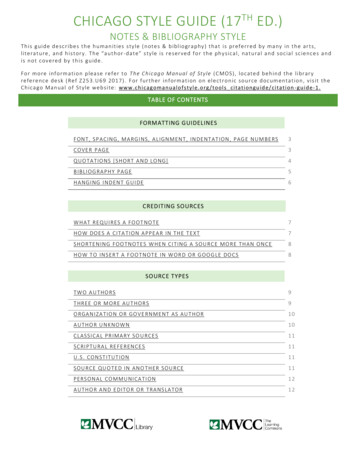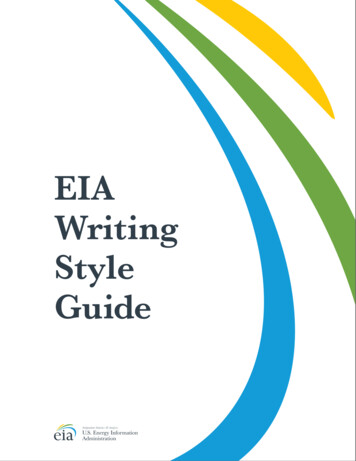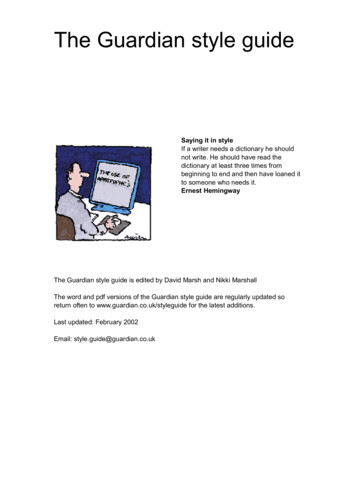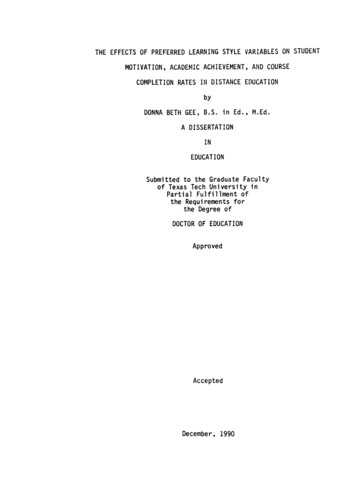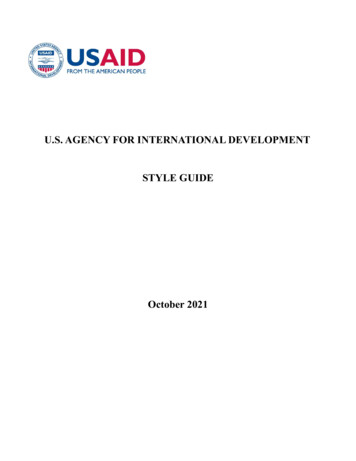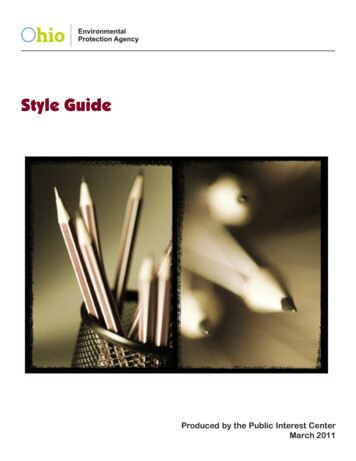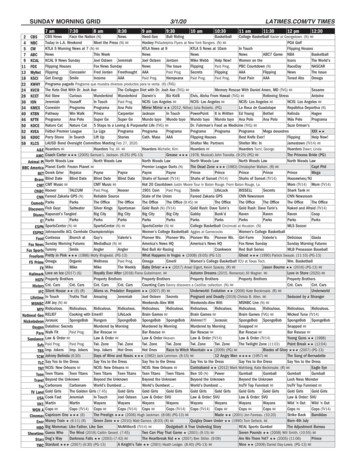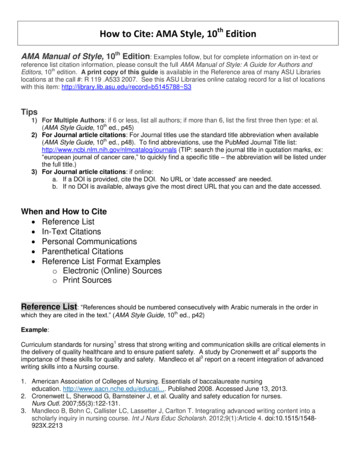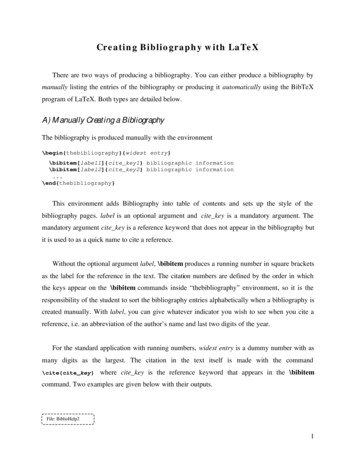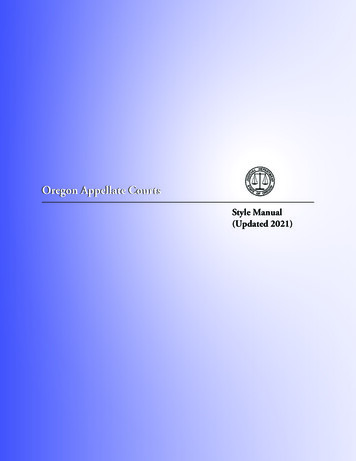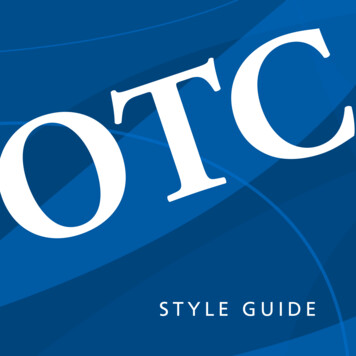
Transcription
STYLE GUIDE1
CONTENTSIntroductionAbout our name.4About our campuses and centers.5Academic Terms and UsageAlumni.6Advisor vs. adviser.6Class vs. course.6Courses and degrees.7Departments and disciplines.8People and titles.8Administrative Style and UsageAddresses and email.10Fax and telephone numbers.11Internet.11Editorial Style PreferencesAbbreviations and acronyms.12Capitalization.12Dates and times.12Gender.13Geographic regions.13Letter spacing.13Punctuation.13Numbers and hyphenation.14States.15Titles of works.15Design, Logos and TypographyColor palettes.16Fonts.17Wordmarks.182
The OTC Communications and Marketing department hasdeveloped this guide to establish a clear, consistent voice in collegepublications. Our goal is to present a uniform style that reflectsOTC’s standards of excellence.OTC has adopted the “Associated Press Stylebook” as its officialstyle guide. For any style questions not addressed in this guide,please refer to the “Associated Press Stylebook.” Please familiarizeyourself with these guidelines and use them in official OTCcommunications. While not required, you are encouraged toadopt these guidelines in any communication in your role as anOTC employee. This guide is not intended to replace other writingstyle guides used for specific purposes, or for publications such asscholarly journals.3
ABOUT OUR NAMEOur official name is Ozarks Technical Community College or OTC.In news releases, feature articles, academic journals and web publications, write out OzarksTechnical Community College on first reference. Use OTC in subsequent references.National media may refer to OTC as Ozarks Tech. Local media, OTC faculty and staff should useOTC when referring to the college.Do not capitalize the college when referring to OTC: Dr. Hal Higdon is the second chancellor inthe 25-year history of the college.A company or organization is always it — not they — when referred to in the singular: OTC offers itsemployees many benefits.4
ABOUT OUR CENTERS AND CAMPUSESOTC has three campuses and two centers. Campuses aredesignated by the Higher Learning Commission and theMissouri Department of Higher Education. Centers offerlimited courses, mainly general education.Do not capitalize campus or center when used alone.Do not hyphenate OTC centers or campuses:OTC-Springfield is incorrect.NAMES OF OTC CAMPUSES AND CENTERS OTC Springfield Campus OTC Richwood Valley Campus OTC Table Rock Campus OTC Waynesville Center OTC Lebanon Center OTC OnlinePlease use the official names of OTC campuses andcenters on first reference. On second reference, OTCSpringfield or the Springfield campus is acceptable.5
ACADEMIC TERMS AND USAGEALUMNI alumnus (singular masculine) alumni (plural masculine — use for collective bodyof men and women) alumna (singular feminine) alumnae (plural feminine — use when referring towomen only) alum/alums (for informal use only)ADVISOR VS. ADVISERUse advisor: I spoke with my academic advisorabout fall courses today.CLASS VS. COURSECourse means a series of classes, on a particular subject,usually lasting a whole semester or year:6 I received three credits for my history course. I have a conflict during Friday’s math class.
DEGREESAn OTC graduate earns an associate degree. Never say or write associate’s degree. Bachelor’s degreesand master’s degrees are possessive.Capitalize specific degrees: Associate of Arts, Associate of Applied Sciences. Lowercase generaldegrees: associate degree, bachelor’s degree, master’s degree.As per AP, all degree abbreviations take periods: A.A., A.S. — Associate of Arts, Associate of Science B.A., B.S. — Bachelor of Arts, Bachelor of Science M.A., M.S. — Master of Arts, Master of Science Ed.D., Ph.D. — Doctor of Education, Doctor of Philosophy M.B.A. — Master of Business AdministrationDo not add the word degree after an abbreviation of the degree: Correct: She has an associate degree in teaching. Correct: She has an Associate of Arts in teaching. Incorrect: She has an A.A. degree in teaching.COURSESLowercase when describing courses in general: I’m taking chemistry this semester.Uppercase the specific course or program: I’m taking Chemistry 101 this semester.7
ACADEMIC TERMS AND USAGEACADEMIC TERMS AND USAGEDEPARTMENTS AND DISCIPLINESPEOPLE AND TITLESCapitalize disciplines only when referring to specificcourses or departments: I’m studying nursing; although,my favorite course is Microbiology 200 in theDepartment of Biological Sciences.Capitalize titles ONLY when preceding personalnames: The governor agrees with Dr. Hal Higdon,chancellor of Ozarks Technical Community College.Provost/Vice Chancellor Steven Bishop meets withOTC instructors.If department precedes the name, capitalize:OTC Department of Marketing and Communications.If department follows the name, lowercase:OTC Marketing and Communications department.OTC faculty members are referred to as instructors.Use abbreviations of degrees after an individual’sname when needed to establish credentials:Steven Bishop, Ph.D.However, do not use both Dr. and degreeabbreviations at the same time: Dr. Steven Bishop,Ph.D. is incorrect.8
9
ADMINISTRATIVE STYLE AND USAGEADDRESS FORMATIn formal letters and invitations:Title First LastCompanyNAME TAGSFirst LastTitleExample:Address (Spell everything out)Mark MillerCity, State ZipCollege Director of CommunicationsExample:Dr. Hal HigdonOzarks Technical Community CollegeIf your title pertains to a specific campus or center,place the campus or center name after your title witha comma.1001 East Chestnut ExpresswayEMAIL FORMATSpringfield, MO 65802Use the following template for faculty/staff emailsignatures:In business letters:Attn: First LastCompanyAddress (The use of abbreviations is acceptable)City, State ZipExample:Attn: Dr. Jeff JochemsOTC Richwood Valley Campus3369 W. Jackson Rd.Nixa, MO 65714NameTitleOzarks Technical Community CollegeAddressWork phone Cell phone (optional)EmailIf your title pertains to a specific campus or center,place the campus or center name after your title witha comma.OTC emails are always lowercase:communications@otc.edu.Do not omit a period when an email address falls atthe end of a sentence.Use san-serif font of either Arial or Calibri.10Please keep email clean and simple. Avoid distractingcolors or backgrounds. Do not use quotes or imagesin your email signature.
FAX AND TELEPHONE NUMBERSSee suggested formats below. Whichever format you choose, handle both fax and phone numbersconsistently throughout your document: (417) 447-7500417-447-7500INTERNETDo not use http:// in printed documents or online. Omit www when possible. Always check webaddresses to ensure they are correct and work properly.Use friendly urls for OTC web addresses: Correct: otc.edu/registerIncorrect: http://www.otc.edu/registrar/register.phpIn online communications, hyperlink web addresses to words or phrases: Learn more here.In printed documents, use a QR code for web addresses that do not have a friendly url.11
EDITORIAL STYLE PREFERENCESABBREVIATIONS AND ACRONYMSWrite out the full names of offices and institutions before using acronyms. Add acronyms in parentheses ifyou intend to use them alone in subsequent references.Several departments within OTC have long titles. Spell out the official name on first reference and revert toabbreviations afterward if desired: Electronic Media Production (EMP).CAPITALIZATIONAvoid unnecessary capitalization of important words. Capitalize proper names but not simple technical terms:OTC prepares for the fall semester.DATES AND TIMESAcademic or fiscal year: 2014–15, 1999–2000,or 2000–01 with a en dash (–).Do not use: 2014-2015, 2014/15, ’14-’15or 14-15.Times: use a.m. and p.m., not AM, pm or othervariations. Using a.m. and morning together isredundant. Likewise, p.m. and evening is redundant:7 p.m. tonight is incorrect.Use noon or midnight instead of 12 p.m. and 12 a.m.Semester and year: fall semester 2015 or fallsemester (no caps).Never use o’clock.Month and year: September 2014 (no comma) Use to between the hours in text: RegFest willor Sept. 14, 2014.run from 10 a.m. to 2 p.m.Avoid use of contractions in dates:September 14th, 2014 is incorrect.Decades: 1990s, ’90s, ’00s.Seasons: the spring of 2014, fall 2014 (seasonsare not capped).12Use a en dash (–) in calendar or tabular entries:Class times are 11 a.m.–noon, 4–5 p.m., and9:30 a.m.–3 p.m.
GENDERAvoid he, she, his or her unless gender is essential tothe meaning. Do not use s/he or his/her.A plural sentence construction often solvesproblems: Donors may pay by credit card if theyso choose.Be careful not to mix singular and plural: Correct: All students have their preferences.Incorrect: Every student has their preference.GEOGRAPHIC REGIONSIn general, capitalize compass points whenreferring to a place: I’m moving to the West Coast.Lowercase when referring to a direction: I’m drivingsouth on Campbell.Lowercase compass points when describing sectionof a nation, state or city: southern MissouriLETTER SPACINGUse one space after a period in printed materials.PUNCTUATIONOTC uses the Oxford comma only in a complex series: Simple series: Café 101 has orange juice,toast and eggs.Complex series: Café 101 has orange juice,toast, and ham and eggs.13
EDITORIAL STYLE PREFERENCESACADEMIC TERMS AND USAGENUMBERSHYPHENATIONSpell out zero through nine in ordinary text, andspell out any number that begins a sentence.Hyphenate compounds that are adjectives: part-timeemployment, decision-making skills.Exceptions include: course numbers, grade pointaverages, unit and monetary values, scores,percentages, compound numbers and decimalfractions — all of which may be indicated withnumerals.Compound adjectives are not hyphenated ifrecognized as a single concept: lower division orupper division class, computer science field, privatesector contributions, real estate markets.Use commas with all numbers above 999:1,000; 13,500; 500,000.Spell out ordinals first through ninth: first grade,21st century, 25th anniversary.Use numbers to represent ages: He has studiedSpanish since the age of 6.Use the word percent or percentage and not %:He shot 54 percent from the field.14Compound adjectives with –ly are not hyphenated:privately funded, highly regarded.
STATESSpell out when state names stand alone. Use AP abbreviations when used with the name of a city in text.Use postal abbreviations in addresses but not in text.Following are the state abbreviations, which also appear in the entries for each state (ZIP code abbreviationsin parentheses):Ala. (AL)Ariz. (AZ)Ark. (AR)Calif. (CA)Colo. (CO)Conn. (CT)Del. (DE)Fla. (FL)Ga. (GA)Ill. (IL)Ind. (IN)Kan. (KS)Ky. (KY)La. (LA)Md. (MD)Mass. (MA)Mich. (MI)Minn. (MN)Miss. (MS)Mo. (MO)Mont. (MT)Neb. (NE)Nev. (NV)N.H. (NH)N.J. (NJ)N.M. (NM)N.Y. (NY)N.C. (NC)N.D. (ND)Okla. (OK)Ore. (OR)Pa. (PA)R.I. (RI)S.C. (SC)S.D. (SD)Tenn. (TN)Vt. (VT)Va. (VA)Wash. (WA)W.Va. (WV)Wis. (WI)Wyo. (WY)These are the ZIP code abbreviations for the eight states that are not abbreviated in datelines or text:AK (Alaska), HI (Hawaii), ID (Idaho), IA (Iowa), ME (Maine), OH (Ohio), TX (Texas), UT (Utah). Also: District ofColumbia (DC).TITLES OF WORKSAs per AP, put quotations around all titles of works: “The Great Gatsby.” Note the following exceptions: The Bible Encyclopedias Almanacs Gazetteers Directories/handbooks Software Dictionaries15
DESIGN, LOGOS AND TYPOGRAPHYCOLOR PALETTESThe official primary OTC color is PMS 295. There are five colors that make up the OTC secondary designcolor palette. When printing in full color, please use the color breaks listed here. The RGB and hex codevalues are also listed for any digital or web applications.Primary:Secondary design color palette:SilverPMS 877CMYK: 0.0.0.40RGB: 153.153.153Hex Code: #999999OTC BluePMS 295CMYK: 100.57.0.40RGB: 0.66.153Hex Code: #004299Bright bluePMS 285CMYK: 100.57.0.0RGB: 0.110.255Hex Code: #006EFFOrangePMS 151CMYK: 0.45.100.0RGB: 255.140.0Hex Code: #FF8C00GreenPMS 375CMYK: 45.0.100.0RGB: 140.255.0Hex Code: #8CFF00MagentaPMS 2395CMYK: 20.100.0.0RGB: 204.0.255Hex Code: #CC00FF16
FONTSThere is one font used to create the OTC wordmark and logo - Adobe Garamond Pro Bold, Small Caps.Adobe Garamond Pro Bold, Small Caps:ABCDEFGHIJKLMNOPQRSTUVWXYZPrimaryThere are two primary fonts used by OTC – one serif and one sans serif.*Adobe Garamond Pro font rstuvwxyzFrutiger font rstuvwxyzSecondaryThere are two secondary fonts used by OTC – one serif and one sans serif.* When the primary fonts arenot available, please use the secondary fonts.Garamond font rstuvwxyzArial font family:(THIS IS THE PREFERRED FONT FOR ONLINE opqrstuvwxyzTertiaryThere are two tertiary fonts used by OTC – one serif and one sans serif.* When the primary and secondaryfonts are not available, please use the tertiary fonts.Times New Roman font rstuvwxyzCalibri font rstuvwxyzStylizedThere are two stylized typefaces used by OTC – Rockwell, which has a bold, collegiate feel, andHansHand, an informal script for student communication. These stylized typefaces should be usedsparingly as design accents only.Rockwell font rstuvwxyzHansHand font rstuvwxyz*Notice the small, decorative flourishes in the strokes of the fonts on the left. These fonts are called serif fonts. The fonts on the right donot have these strokes and are called sans-serif fonts. Serif fonts are best for printed materials. San-serif fonts are best for online content.17
DESIGN, LOGOS AND TYPOGRAPHYWORDMARKSWordmarks are available for download on the News & Information page as eps or jpg formats. Whentreating the name of the college in a graphic context, use only the eps or jpg files; do not attempt torecreate them using actual type on your document. If you have questions or concerns about whichwordmark should be used in a particular instance, please contact the Communications and Marketingdepartment at creativeservices@otc.edu for clarification.There are two official wordmarks shown below. One version is a stacked version of the wordmark whilethe other is a single line. Both are available in OTC blue, black and white.18
Other approved wordmarks can be used in OTC blue, black or white:Other approved logos:19
Technical Community College on first reference. Use OTC in subsequent references. National media may refer to OTC as Ozarks Tech. Local media, OTC faculty and staff should use OTC when referring to the college. Do not capitalize the college when referring to OTC: Dr. Hal Higdon is the second chancellor in the 25-year history of the college.
